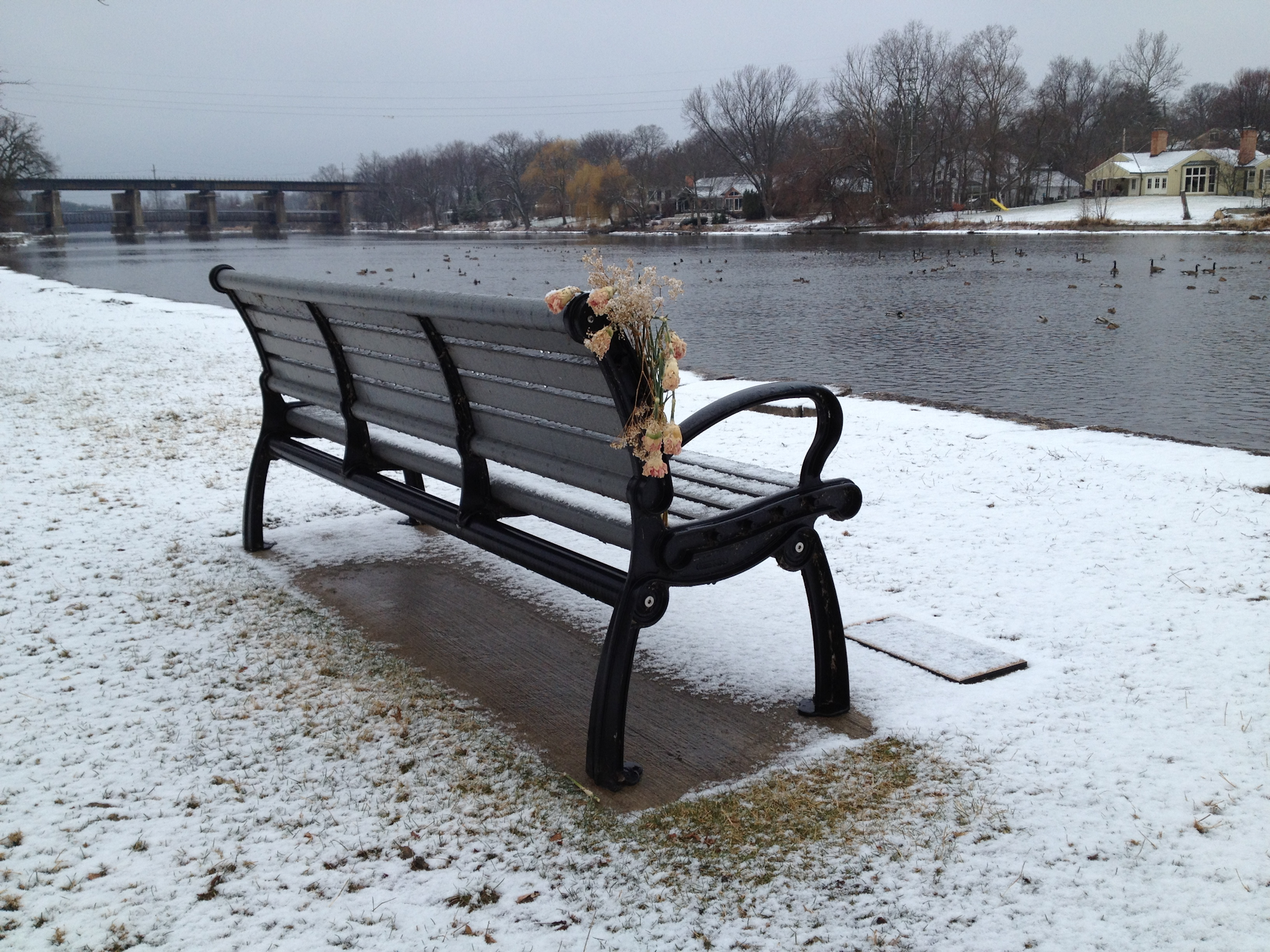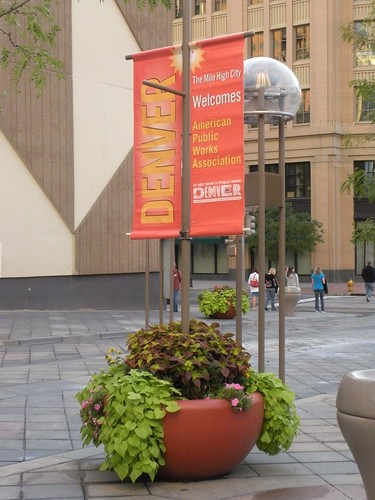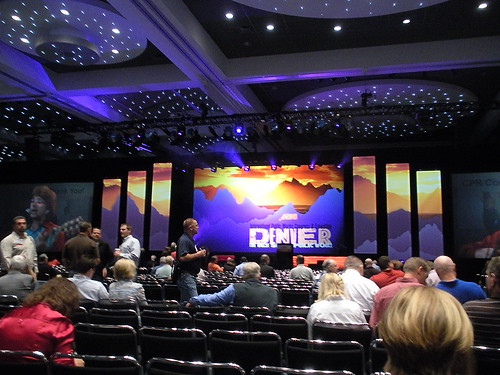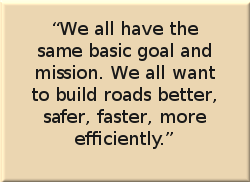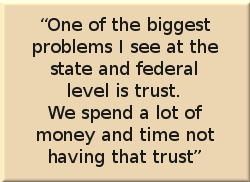This year's International Public Works Conference & Exposition is being held in Denver, Colorado. The event opened yesterday morning with a welcome by the outgoing president, George Crombie, and a transfer of leadership to the new president, Diane M. Linderman.
First General Session – Michael Hayden
The first general session followed with keynote speaker, Michael Hayden, retired U.S. Air Force Four Star General and former director of the CIA and NSA. General Hayden shared stories of his time as director of each agency and offered his insight into leadership.
One interesting remark he made was that we advance in our careers by doing things right, but eventually we reach a level where we only advance by doing the right thing. To me, I see within this remark one of the biggest challenges we face as we advance in local government to an appointed position. Many probably did get there by doing something the right way. But once in this upper-level position, decisions are not only made by analyzing technical information, but also understanding and weighing political factors. Even so, as a public works professional it is imperative in the end we do the right thing which can often be a balance of technical and political considerations. But this can become difficult when an elected official wants to do something for purely political reasons like getting more votes. How many of us have seen others in our field let go or blamed for problems due to refusing to go along with a decision that was made to advance a political career?
The risk of being put in this situation is one of the main reasons I hear cited for why someone left local government for the private sector or why someone would not take an appointed position. Fortunately not every elected official or even local government operates this way or demands their appointed staff do whatever they say regardless of what is "right." But it is unfortunate that this seems to be enough to scare off some people who would have made great managers.
Expo
After the general session, everyone went to the exposition hall to eat and visit the exhibits. Usually I like to take time to talk with different vendors, take photos to share with co-workers or with readers of this blog, or even record videos of the demonstrations. But this year, I noticed in the brochure that photos and videos were not allowed in the expo hall. I went to the press room to register as press to see if this would allow me to take photos or record videos, but they said no. This is really unfortunate because I think as someone working in the industry every day, like most of you, I probably will ask vendors many of the same questions you would ask. How many times have you watched a demo and thought, "well that all sounds good, but what about this?" So by recording the demo given to me, readers who maybe could not attend the show can still get the benefit of the demo and have typical questions answered. And the vendors get the benefit of having their demo reach a much wider audience.
In a way, this refusal to allow sharing of information is somewhat contradictory to the increased integration of social media into the conference. This year, APWA is more actively tweeting the show with events and give-a-ways announced regularly throughout the day. Vendors have even been sending out tweets offering prizes for those showing up with passwords for mentioning the tweet. I was given a cute little dump truck by CH2MHill yesterday for seeing their tweet, showing up at their booth, and mentioning the tweet. Anyone at the show can see the stream by following the hashtag #APWAEXPO. The other great consequence of following the hashtag is that I was able to find new people in public works to follow. And at the end of the day, one of the more active people tweeting, mpbaldauf, even stopped by and introduced herself so I got to meet her in person.
The other great addition to this year's conference is the ability to watch and participate from a distance. If you couldn't make it to Denver, but still want to check out the events, make sure you register here: APWA Live!
FHWA Update by Victor Mendez
I was impressed that the director of FHWA, Victor Mendez, took time to attend the conference and present at a session. He talked about the President's proposed jobs bill. The President is asking for Congress to fund $50 billion of infrastructure improvements, $27 billion of which is targeted for roads and bridges. Funds will also be available for improvements to water and energy systems and schools. Most in our field would probably not have been surprised to hear there is up to 30% unemployment in the construction industry in some regions. And the idea is this bill will significantly help put many of those unemployed back to work.
On top of this, Mendez said the President has proposed to set aside another $10 billion as seed money to establish an infrastructure bank. According to him, project funding decisions will be based upon "how bad is the project needed, and how much good will it do for the economy?"
Mendez shared an example of why this investment in our infrastructure is so critical. About a week or so ago, the Sherman Mitten bridge connecting Kentucky and Indiana was closed due to cracks in structural members found by inspectors. The closure of this bridge has resulted in major disruption and cost for commuters and companies moving goods through this corridor. (You can read more about the bridge closure here: Midwest Jammed by Bridge Closing.)
He also discussed transportation funding and the extension of the highway bill. And then he went on to discuss the Every Day Counts program. This initiative is focused on shortening project delivery and promoting the use of innovative construction and design techniques. Mendez said, "EDC is part of larger effort to speed up recovery and create jobs and win the future." But he also explained he was trying to create something that will not just be another short-term program, but an idea that will "infuse the industry with a culture of innovation" and be in place long after he is no longer director. His vision includes the creation of "councils in each state that include people from all levels of government and private sector that will meet on a regular basis." These councils will be tasked with deciding which components of EDC work best in that state and will oversee efforts to shorten project delivery.
Finally, he concluded by talking about the safety programs promoted by Secretary of Transportation Ray LaHood. These include distracted driving legislation and implementation of safety edge. Mendez also encouraged us to "become safety ambassadors for all of us."
Social Media as a Public Works Asset
For me, the final session of the day was one in which I participated as a co-presenter with Robert Lewis. We introduced social media tools that agencies are using and discussed how others were leveraging these tools as assets for their organization. Then we suggested there are two alternatives for each agency to choose – either to ignore or ban the use of social media or to use it and engage. We emphasized the need to create a policy and provide guidance to staff no matter which alternative is chosen. And of course, we advised agencies to consider legal issues and concerns as they make their decisions and implement their policies.
